Han Lin
EPiC: Efficient Video Camera Control Learning with Precise Anchor-Video Guidance
May 28, 2025Abstract:Recent approaches on 3D camera control in video diffusion models (VDMs) often create anchor videos to guide diffusion models as a structured prior by rendering from estimated point clouds following annotated camera trajectories. However, errors inherent in point cloud estimation often lead to inaccurate anchor videos. Moreover, the requirement for extensive camera trajectory annotations further increases resource demands. To address these limitations, we introduce EPiC, an efficient and precise camera control learning framework that automatically constructs high-quality anchor videos without expensive camera trajectory annotations. Concretely, we create highly precise anchor videos for training by masking source videos based on first-frame visibility. This approach ensures high alignment, eliminates the need for camera trajectory annotations, and thus can be readily applied to any in-the-wild video to generate image-to-video (I2V) training pairs. Furthermore, we introduce Anchor-ControlNet, a lightweight conditioning module that integrates anchor video guidance in visible regions to pretrained VDMs, with less than 1% of backbone model parameters. By combining the proposed anchor video data and ControlNet module, EPiC achieves efficient training with substantially fewer parameters, training steps, and less data, without requiring modifications to the diffusion model backbone typically needed to mitigate rendering misalignments. Although being trained on masking-based anchor videos, our method generalizes robustly to anchor videos made with point clouds during inference, enabling precise 3D-informed camera control. EPiC achieves SOTA performance on RealEstate10K and MiraData for I2V camera control task, demonstrating precise and robust camera control ability both quantitatively and qualitatively. Notably, EPiC also exhibits strong zero-shot generalization to video-to-video scenarios.
Training-free Guidance in Text-to-Video Generation via Multimodal Planning and Structured Noise Initialization
Apr 11, 2025Abstract:Recent advancements in text-to-video (T2V) diffusion models have significantly enhanced the visual quality of the generated videos. However, even recent T2V models find it challenging to follow text descriptions accurately, especially when the prompt requires accurate control of spatial layouts or object trajectories. A recent line of research uses layout guidance for T2V models that require fine-tuning or iterative manipulation of the attention map during inference time. This significantly increases the memory requirement, making it difficult to adopt a large T2V model as a backbone. To address this, we introduce Video-MSG, a training-free Guidance method for T2V generation based on Multimodal planning and Structured noise initialization. Video-MSG consists of three steps, where in the first two steps, Video-MSG creates Video Sketch, a fine-grained spatio-temporal plan for the final video, specifying background, foreground, and object trajectories, in the form of draft video frames. In the last step, Video-MSG guides a downstream T2V diffusion model with Video Sketch through noise inversion and denoising. Notably, Video-MSG does not need fine-tuning or attention manipulation with additional memory during inference time, making it easier to adopt large T2V models. Video-MSG demonstrates its effectiveness in enhancing text alignment with multiple T2V backbones (VideoCrafter2 and CogVideoX-5B) on popular T2V generation benchmarks (T2VCompBench and VBench). We provide comprehensive ablation studies about noise inversion ratio, different background generators, background object detection, and foreground object segmentation.
DreamRunner: Fine-Grained Storytelling Video Generation with Retrieval-Augmented Motion Adaptation
Nov 25, 2024
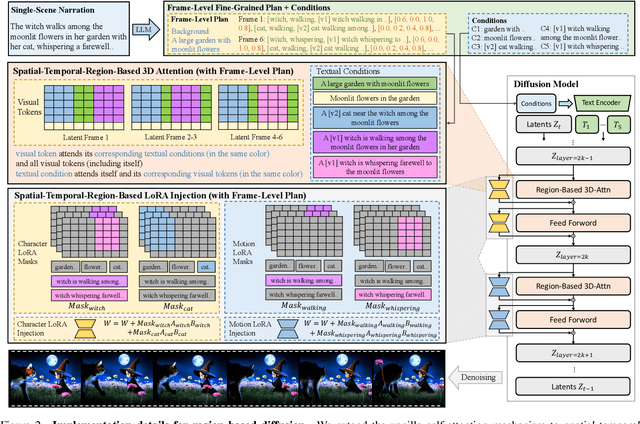
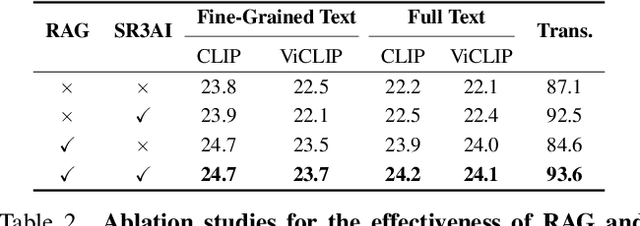
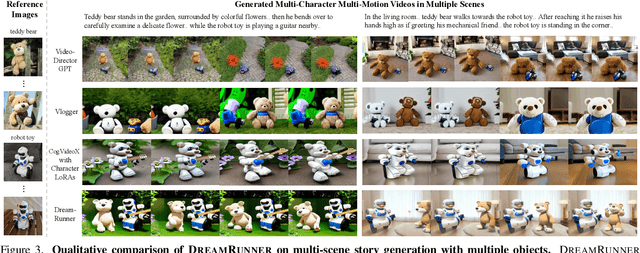
Abstract:Storytelling video generation (SVG) has recently emerged as a task to create long, multi-motion, multi-scene videos that consistently represent the story described in the input text script. SVG holds great potential for diverse content creation in media and entertainment; however, it also presents significant challenges: (1) objects must exhibit a range of fine-grained, complex motions, (2) multiple objects need to appear consistently across scenes, and (3) subjects may require multiple motions with seamless transitions within a single scene. To address these challenges, we propose DreamRunner, a novel story-to-video generation method: First, we structure the input script using a large language model (LLM) to facilitate both coarse-grained scene planning as well as fine-grained object-level layout and motion planning. Next, DreamRunner presents retrieval-augmented test-time adaptation to capture target motion priors for objects in each scene, supporting diverse motion customization based on retrieved videos, thus facilitating the generation of new videos with complex, scripted motions. Lastly, we propose a novel spatial-temporal region-based 3D attention and prior injection module SR3AI for fine-grained object-motion binding and frame-by-frame semantic control. We compare DreamRunner with various SVG baselines, demonstrating state-of-the-art performance in character consistency, text alignment, and smooth transitions. Additionally, DreamRunner exhibits strong fine-grained condition-following ability in compositional text-to-video generation, significantly outperforming baselines on T2V-ComBench. Finally, we validate DreamRunner's robust ability to generate multi-object interactions with qualitative examples.
VEDIT: Latent Prediction Architecture For Procedural Video Representation Learning
Oct 04, 2024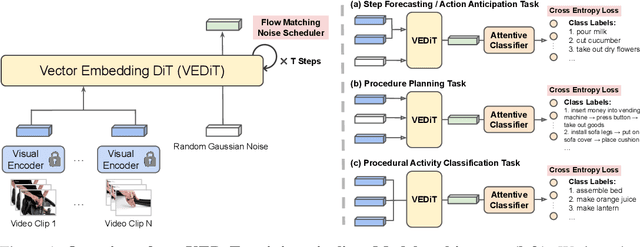

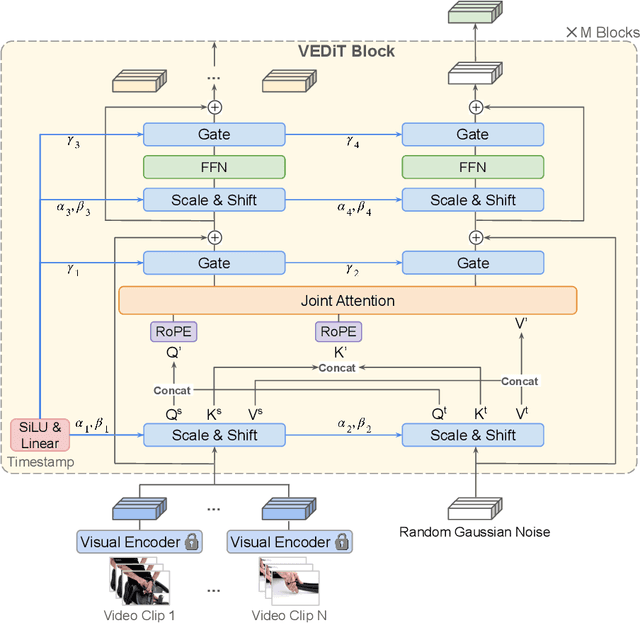
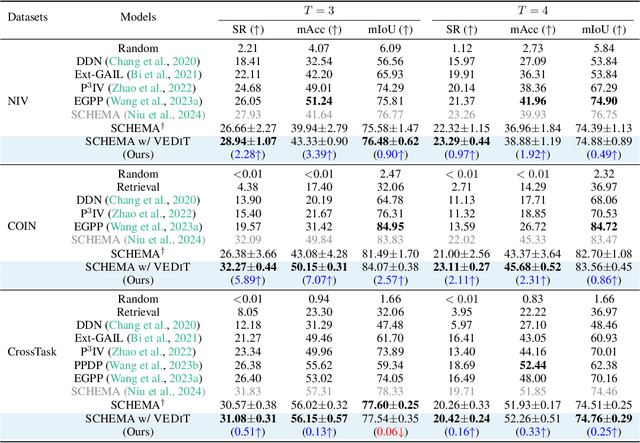
Abstract:Procedural video representation learning is an active research area where the objective is to learn an agent which can anticipate and forecast the future given the present video input, typically in conjunction with textual annotations. Prior works often rely on large-scale pretraining of visual encoders and prediction models with language supervision. However, the necessity and effectiveness of extending compute intensive pretraining to learn video clip sequences with noisy text supervision have not yet been fully validated by previous works. In this work, we show that a strong off-the-shelf frozen pretrained visual encoder, along with a well designed prediction model, can achieve state-of-the-art (SoTA) performance in forecasting and procedural planning without the need for pretraining the prediction model, nor requiring additional supervision from language or ASR. Instead of learning representations from pixel space, our method utilizes the latent embedding space of publicly available vision encoders. By conditioning on frozen clip-level embeddings from observed steps to predict the actions of unseen steps, our prediction model is able to learn robust representations for forecasting through iterative denoising - leveraging the recent advances in diffusion transformers (Peebles & Xie, 2023). Empirical studies over a total of five procedural learning tasks across four datasets (NIV, CrossTask, COIN and Ego4D-v2) show that our model advances the strong baselines in long-horizon action anticipation (+2.6% in Verb ED@20, +3.1% in Noun ED@20), and significantly improves the SoTA in step forecasting (+5.0%), task classification (+3.8%), and procedure planning tasks (up to +2.28% in success rate, +3.39% in mAcc, and +0.90% in mIoU).
Fast Tree-Field Integrators: From Low Displacement Rank to Topological Transformers
Jun 22, 2024Abstract:We present a new class of fast polylog-linear algorithms based on the theory of structured matrices (in particular low displacement rank) for integrating tensor fields defined on weighted trees. Several applications of the resulting fast tree-field integrators (FTFIs) are presented, including (a) approximation of graph metrics with tree metrics, (b) graph classification, (c) modeling on meshes, and finally (d) Topological Transformers (TTs) (Choromanski et al., 2022) for images. For Topological Transformers, we propose new relative position encoding (RPE) masking mechanisms with as few as three extra learnable parameters per Transformer layer, leading to 1.0-1.5%+ accuracy gains. Importantly, most of FTFIs are exact methods, thus numerically equivalent to their brute-force counterparts. When applied to graphs with thousands of nodes, those exact algorithms provide 5.7-13x speedups. We also provide an extensive theoretical analysis of our methods.
MMT-Bench: A Comprehensive Multimodal Benchmark for Evaluating Large Vision-Language Models Towards Multitask AGI
Apr 24, 2024



Abstract:Large Vision-Language Models (LVLMs) show significant strides in general-purpose multimodal applications such as visual dialogue and embodied navigation. However, existing multimodal evaluation benchmarks cover a limited number of multimodal tasks testing rudimentary capabilities, falling short in tracking LVLM development. In this study, we present MMT-Bench, a comprehensive benchmark designed to assess LVLMs across massive multimodal tasks requiring expert knowledge and deliberate visual recognition, localization, reasoning, and planning. MMT-Bench comprises $31,325$ meticulously curated multi-choice visual questions from various multimodal scenarios such as vehicle driving and embodied navigation, covering $32$ core meta-tasks and $162$ subtasks in multimodal understanding. Due to its extensive task coverage, MMT-Bench enables the evaluation of LVLMs using a task map, facilitating the discovery of in- and out-of-domain tasks. Evaluation results involving $30$ LVLMs such as the proprietary GPT-4V, GeminiProVision, and open-sourced InternVL-Chat, underscore the significant challenges posed by MMT-Bench. We anticipate that MMT-Bench will inspire the community to develop next-generation multimodal foundation models aimed at achieving general-purpose multimodal intelligence.
Ctrl-Adapter: An Efficient and Versatile Framework for Adapting Diverse Controls to Any Diffusion Model
Apr 15, 2024Abstract:ControlNets are widely used for adding spatial control in image generation with different conditions, such as depth maps, canny edges, and human poses. However, there are several challenges when leveraging the pretrained image ControlNets for controlled video generation. First, pretrained ControlNet cannot be directly plugged into new backbone models due to the mismatch of feature spaces, and the cost of training ControlNets for new backbones is a big burden. Second, ControlNet features for different frames might not effectively handle the temporal consistency. To address these challenges, we introduce Ctrl-Adapter, an efficient and versatile framework that adds diverse controls to any image/video diffusion models, by adapting pretrained ControlNets (and improving temporal alignment for videos). Ctrl-Adapter provides diverse capabilities including image control, video control, video control with sparse frames, multi-condition control, compatibility with different backbones, adaptation to unseen control conditions, and video editing. In Ctrl-Adapter, we train adapter layers that fuse pretrained ControlNet features to different image/video diffusion models, while keeping the parameters of the ControlNets and the diffusion models frozen. Ctrl-Adapter consists of temporal and spatial modules so that it can effectively handle the temporal consistency of videos. We also propose latent skipping and inverse timestep sampling for robust adaptation and sparse control. Moreover, Ctrl-Adapter enables control from multiple conditions by simply taking the (weighted) average of ControlNet outputs. With diverse image/video diffusion backbones (SDXL, Hotshot-XL, I2VGen-XL, and SVD), Ctrl-Adapter matches ControlNet for image control and outperforms all baselines for video control (achieving the SOTA accuracy on the DAVIS 2017 dataset) with significantly lower computational costs (less than 10 GPU hours).
EnvGen: Generating and Adapting Environments via LLMs for Training Embodied Agents
Mar 18, 2024



Abstract:Recent SOTA approaches for embodied learning via interaction directly employ large language models (LLMs) as agents to determine the next steps in an environment. Due to their world knowledge and reasoning capabilities, LLM agents achieve stronger performance than previous smaller agents based on reinforcement learning (RL); however, frequently calling LLMs is slow and expensive. Instead of directly employing LLMs as agents, can we use LLMs' reasoning capabilities to adaptively create training environments to help smaller embodied RL agents learn useful skills that they are weak at? We propose EnvGen, a novel framework to address this question. First, we prompt an LLM to generate training environments that allow agents to quickly learn different tasks in parallel. Concretely, the LLM is given the task description and simulator objectives that the agents should learn and is then asked to generate a set of environment configurations (e.g., different terrains, items given to agents, etc.). Next, we train a small RL agent in a mixture of the original and LLM-generated environments. Then, we enable the LLM to continuously adapt the generated environments to progressively improve the skills that the agent is weak at, by providing feedback to the LLM in the form of the agent's performance. We demonstrate the usefulness of EnvGen with comprehensive experiments in Crafter and Heist environments. We find that a small RL agent trained with EnvGen can outperform SOTA methods, including a GPT-4 agent, and learns long-horizon tasks significantly faster. We show qualitatively how the LLM adapts training environments to help improve RL agents' weaker skills over time. Additionally, EnvGen is substantially more efficient as it only uses a small number of LLM calls (e.g., 4 in total), whereas LLM agents require thousands of LLM calls. Lastly, we present detailed ablation studies for our design choices.
DiagrammerGPT: Generating Open-Domain, Open-Platform Diagrams via LLM Planning
Oct 18, 2023



Abstract:Text-to-image (T2I) generation has seen significant growth over the past few years. Despite this, there has been little work on generating diagrams with T2I models. A diagram is a symbolic/schematic representation that explains information using structurally rich and spatially complex visualizations (e.g., a dense combination of related objects, text labels, directional arrows, connection lines, etc.). Existing state-of-the-art T2I models often fail at diagram generation because they lack fine-grained object layout control when many objects are densely connected via complex relations such as arrows/lines and also often fail to render comprehensible text labels. To address this gap, we present DiagrammerGPT, a novel two-stage text-to-diagram generation framework that leverages the layout guidance capabilities of LLMs (e.g., GPT-4) to generate more accurate open-domain, open-platform diagrams. In the first stage, we use LLMs to generate and iteratively refine 'diagram plans' (in a planner-auditor feedback loop) which describe all the entities (objects and text labels), their relationships (arrows or lines), and their bounding box layouts. In the second stage, we use a diagram generator, DiagramGLIGEN, and a text label rendering module to generate diagrams following the diagram plans. To benchmark the text-to-diagram generation task, we introduce AI2D-Caption, a densely annotated diagram dataset built on top of the AI2D dataset. We show quantitatively and qualitatively that our DiagrammerGPT framework produces more accurate diagrams, outperforming existing T2I models. We also provide comprehensive analysis including open-domain diagram generation, vector graphic diagram generation in different platforms, human-in-the-loop diagram plan editing, and multimodal planner/auditor LLMs (e.g., GPT-4Vision). We hope our work can inspire further research on diagram generation via T2I models and LLMs.
VideoDirectorGPT: Consistent Multi-scene Video Generation via LLM-Guided Planning
Sep 26, 2023Abstract:Although recent text-to-video (T2V) generation methods have seen significant advancements, most of these works focus on producing short video clips of a single event with a single background (i.e., single-scene videos). Meanwhile, recent large language models (LLMs) have demonstrated their capability in generating layouts and programs to control downstream visual modules such as image generation models. This raises an important question: can we leverage the knowledge embedded in these LLMs for temporally consistent long video generation? In this paper, we propose VideoDirectorGPT, a novel framework for consistent multi-scene video generation that uses the knowledge of LLMs for video content planning and grounded video generation. Specifically, given a single text prompt, we first ask our video planner LLM (GPT-4) to expand it into a 'video plan', which involves generating the scene descriptions, the entities with their respective layouts, the background for each scene, and consistency groupings of the entities and backgrounds. Next, guided by this output from the video planner, our video generator, Layout2Vid, has explicit control over spatial layouts and can maintain temporal consistency of entities/backgrounds across scenes, while only trained with image-level annotations. Our experiments demonstrate that VideoDirectorGPT framework substantially improves layout and movement control in both single- and multi-scene video generation and can generate multi-scene videos with visual consistency across scenes, while achieving competitive performance with SOTAs in open-domain single-scene T2V generation. We also demonstrate that our framework can dynamically control the strength for layout guidance and can also generate videos with user-provided images. We hope our framework can inspire future work on better integrating the planning ability of LLMs into consistent long video generation.
 Add to Chrome
Add to Chrome Add to Firefox
Add to Firefox Add to Edge
Add to Edge